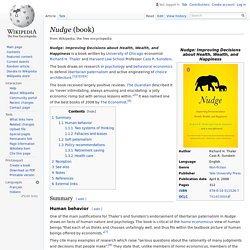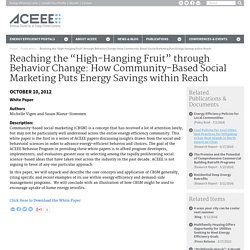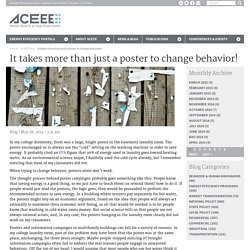

Heath Brothers. Book & Blog - Nudge: Improving Decisions About Health, Wealth, and Happiness. Book - Nudge. Nudge: Improving Decisions about Health, Wealth, and Happiness is a book written by University of Chicago economist Richard H.

Thaler and Harvard Law School Professor Cass R. Sunstein. The book draws on research in psychology and behavioral economics to defend libertarian paternalism and active engineering of choice architecture.[1][2][3][4] The book received largely positive reviews. The Guardian described it as "never intimidating, always amusing and elucidating: a jolly economic romp but with serious lessons within One of the main justifications for Thaler's and Sunstein's endorsement of libertarian paternalism in Nudge draws on facts of human nature and psychology. The book describes two systems that characterize human thinking, which Sunstein and Thaler refer to as the "Reflective System" and the "Automatic System".[9] These two systems are more thoroughly defined in Daniel Kahneman's book Thinking, Fast and Slow. The Reflective System is deliberate and self-conscious. Book Summary: Yes! 50 Scientifically Proven Ways to be Persuasive.
Yes!

50 Scientifically Proven Ways To Be Persuasive This book is an attempt to focus on persuasion as a science rather than an art. It relies on a significant body of research to compile this list. 1) Social Proof – People look outside themselves to justify their actions. You can persuade individuals by highlighting that a majority of people do ‘x’. 2) More individualized messages get greater results. 3) Social proof can backfire if you are showing that the wrong course of action is popular. 4) People who deviate from the average will move toward the average. 5) For those acting in a socially desirable way, there needs to be praise or positive reinforcement of the good behavior. 6) Too many choices overwhelm people unless people are already clear about their options. 7) When giving a free gift with an item, the value of the free item declines in the mind of the purchaser. 8 )When multiple products are offered, the middle item is often selected as the compromise approach.
Be Sociable, Share! Horizon House Environmental and Sustainability Vision. Overview - Saving Energy with Neighborly Behavior. Description: Tenant engagement programs encourage the people who live in a multifamily property to change their behavior in order to achieve a goal. These programs are an attractive option for owners or managers who want to improve energy efficiency. In this report, we assess the key features of existing programs, make recommendations for improvements that housing providers and advocates can use immediately, and outline a wish list for the future.
In late 2013 and early 2014, ACEEE conducted a series of surveys and interviews to examine the current landscape of tenant engagement programs in the United States. The focus of this report is on tenants living in multifamily buildings that operate energy efficiency programs. White Paper - Saving Energy with Neighborly Behavior. Reaching the “High-Hanging Fruit” with Behavior Change & Social Marketing.
Description: Community-based social marketing (CBSM) is a concept that has received a lot of attention lately, but may not be particularly well understood across the entire energy efficiency community.

This white paper is the first in a series of ACEEE papers discussing insights drawn from the social and behavioral sciences in order to advance energy-efficient behavior and choices. The goal of the ACEEE Behavior Program in providing these white papers is to afford program developers, implementers, and evaluators greater ease in selecting among the rapidly proliferating social science-based ideas that have taken root across the industry in the past decade.
ACEEE is not arguing in favor of any one particular approach. In this paper, we will unpack and describe the core concepts and application of CBSM generally, citing specific and recent examples of its use within energy efficiency and demand-side management programs. It Takes More Than Just a Poster to Change Behavior! In my college dormitory, there was a large, bright poster in the basement laundry room.

The poster encouraged us to always use the “cold” setting on the washing machine in order to save energy. It probably cited an EPA figure that 90% of energy used in laundry goes toward heating water. As an environmental science major, I dutifully used the cold cycle already, but I remember noticing that most of my classmates did not. When trying to change behavior, posters alone don’t work. The thought process behind poster campaigns probably goes something like this: People know that saving energy is a good thing, so we just have to teach them (or remind them) how to do it.
Posters and information campaigns in multifamily buildings can fail for a variety of reasons. Behavior programs (like the laundry information campaign from my college years) are being run all over the country in apartment buildings, co-ops, and condominiums. Having a poster is a good start.